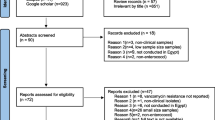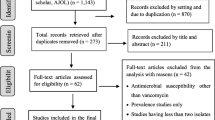Abstract
Vancomycin-resistant Enterococcus (VRE) is considered to be a major nosocomial pathogen that results in serious morbidity and mortality worldwide. Limited information is available concerning the prevalence of VRE infections in Iran. We carried out a systematic search by using different electronic databases including: Medline (via PubMed), Embase, Web of Science, and the Iranian Database. Meta-analysis was performed using comprehensive meta-analysis software. The meta-analyses revealed that the prevalence of VRE infections was 9.4 % (95 % confidence interval [95 % CI] 7.3–12) among culture-positive cases for Enterococcus species. The prevalence of VRE in Iran is compared with the results of developed countries. The prevalence of VRE in Germany, the United Kingdom (UK), and Italy was 11.2 %, 8.5–12.5 %, and 9 % respectively. Additionally, the frequency of vancomycin resistance among E. faecalis isolates was higher than for E. faecium. The results of this study indicate that a comprehensive infection control strategy based on hand hygiene, educating the hospital staff members, providing clinical guidance and principles for the appropriate use of antibiotics, sanitizing the hospitals, contact precautions, and active surveillance systems on the basis of international criteria is urgently needed.



Similar content being viewed by others
References
Prematunge C, MacDougall C, Johnstone J, Adomako K, Lam F, Robertson J et al (2016) VRE and VSE bacteremia outcomes in the era of effective VRE therapy: a systematic review and meta-analysis. Infect Control Hosp Epidemiol 37(1):26–35
Cetinkaya Y, Falk P, Mayhall CG (2000) Vancomycin-resistant enterococci. Clin Microbiol Rev 13(4):686–707
Balli EP, Venetis CA, Miyakis S (2014) Systematic review and meta-analysis of linezolid versus daptomycin for treatment of vancomycin-resistant enterococcal bacteremia. Antimicrob Agents Chemother 58(2):734–739
Corso AC, Gagetti PS, Rodriguez MM, Melano RG, Ceriana PG, Faccone DF et al (2007) Molecular epidemiology of vancomycin-resistant Enterococcus faecium in Argentina. Int J Infect Dis 11(1):69–75
Emaneini M, Aligholi M, Aminshahi M (2008) Characterization of glycopeptides, aminoglycosides and macrolide resistance among Enterococcus faecalis and Enterococcus faecium isolates from hospitals in Tehran. Pol J Microbiol 7(2):173–178
Feizabadi MM, Asadi S, Zohari M, Gharavi S, Etemadi G (2004) Genetic characterization of high-level gentamicin-resistant strains of Enterococcus faecalis in Iran. Can J Microbiol 50(10):869–872
Cosgrove SE (2006) The relationship between antimicrobial resistance and patient outcomes: mortality, length of hospital stay, and health care costs. Clin Infect Dis 42 [Suppl 2]:S82–S89
Dadfarma N, Imani Fooladi AA, Oskoui M, Mahmoodzadeh Hosseini H (2013) High level of gentamicin resistance (HLGR) among enterococcus strains isolated from clinical specimens. J Infect Public Health 6(3):202–208
Sharifi Y, Hasani A, Ghotaslou R, Varshochi M, Hasani A, Soroush MH et al (2012) Vancomycin-resistant enterococci among clinical isolates from north-west Iran: identification of therapeutic surrogates. J Med Microbiol 61(Pt 4):600–602
Shokoohizadeh L, Mobarez AM, Zali MR, Ranjbar R, Alebouyeh M, Sakinc T et al (2013) High frequency distribution of heterogeneous vancomycin resistant Enterococcus faecium (VREfm) in Iranian hospitals. Diagn Pathol 8:163
Shokri D, Zaghian S, Khodabakhsh F, Fazeli H, Mobasherizadeh S, Ataei B (2014) Antimicrobial activity of a UV-stable bacteriocin-like inhibitory substance (BLIS) produced by Enterococcus faecium strain DSH20 against vancomycin-resistant Enterococcus (VRE) strains. J Microbiol Immunol Infect 47(5):371–376
Talebi M, Sadeghi J, Pourshafie MR (2014) Molecular characterization of vancomycin-resistant Enterococcus faecium isolated from intensive care units. Curr Microbiol 68(5):615–620
Moher D, Liberati A, Tetzlaff J, Altman DG (2009) Preferred reporting items for systematic reviews and meta-analyses: the PRISMA statement. Ann Intern Med 151(4):264–269
Performance Standards for Antimicrobial Susceptibility Testing (2014) Twenty-fourth informational supplement, CLSI, M100-S24
Joanna Briggs Institute (2014) Joanna Briggs Institute Reviewers’ Manual: 2014 edition. The Joanna Briggs Institute Australia
Werner G, Coque TM, Hammerum AM, Hope R, Hryniewicz W, Johnson A et al (2008) Emergence and spread of vancomycin resistance among enterococci in Europe. Euro Surveill 13(47):1–11
The European Antimicrobial Resistance Surveillance System. EARSS results [database on the internet]. [Cited 20.10.2008]. Available from: http://www.rivm.nl/earss/result/
Brown DF, Hope R, Livermore DM, Brick G, Broughton K, George RC et al (2008) Non-susceptibility trends among enterococci and non-pneumococcal streptococci from bacteraemias in the UK and Ireland, 2001–06. J Antimicrob Chemother 62 [Suppl 2]:ii75–85
British Society for Antimicrobial Chemotherapy (BSAC). Resistance Surveillance Project. Available from: http://www.bsac.org.uk/resistance_surveillance.cfm
Fontana R, Ligozzi M, Mazzariol A, Veneri G, Cornaglia G (1998) Resistance of enterococci to ampicillin and glycopeptide antibiotics in Italy. The Italian Surveillance Group for Antimicrobial Resistance. Clin Infect Dis 27 [Suppl 1]:S84–S86
Larson EL, Early E, Cloonan P, Sugrue S, Parides M (2000) An organizational climate intervention associated with increased handwashing and decreased nosocomial infections. Behav Med 26(1):14–22
Zhang S, Sun X, Chang W, Dai Y, Ma X (2015) Systematic review and meta-analysis of the epidemiology of vancomycin-intermediate and heterogeneous vancomycin-intermediate Staphylococcus aureus isolates. PLoS One 10(8):e0136082
Alp E, Leblebicioglu H, Doganay M, Voss A (2011) Infection control practice in countries with limited resources. Ann Clin Microbiol Antimicrob 10:36
Mamishi S, Pourakbari B, Teymuri M, Babamahmoodi A, Mahmoudi S (2014) Management of hospital infection control in Iran: a need for implementation of multidisciplinary approach. Osong Public Health Res Perspect 5(4):179–186
Pittet D, Allegranzi B, Storr J, Bagheri Nejad S, Dziekan G, Leotsakos A et al (2008) Infection control as a major World Health Organization priority for developing countries. J Hosp Infect 68(4):285–292
Akhi MT, Farzaneh F, Oskouei M (2009) Study of enterococcal susceptibility patterns isolated from clinical specimens in Tabriz, Iran. Pak J Med Sci 25(2):211–216
Aleyasin A, Mobarez AM, Sadeghizadeh M, Hosseini Doust R, Khoramabadi N (2007) Resistance to vancomycin in Enterococcus faecium and faecalis clinical isolates. Pak J Med Sci 23(3):390–393
Talebi M, Pourshafie MR, Oskouii M, Eshraghi SS (2008) Molecular analysis of vanHAX element in vancomycin resistant enterococci isolated from hospitalized patients in Tehran. Iran Biomed J 12(4):223–228
Pourshafie MR, Talebi M, Saifi M, Katouli M, Eshraghi S, Kuhn I et al (2008) Clonal heterogeneity of clinical isolates of vancomycin-resistant Enterococcus faecium with unique vanS. Trop Med Int Health 13(5):722–727
Japoni A, Farshad S, Ziyaeyan M, Ziaian S (2009) Detection of Van-positive and negative vancomycin resistant enterococci and their antibacterial susceptibility patterns to the newly introduced antibiotics. Pak J Biol Sci 12(11):844–851
Yasliani S, Mohabati Mobarez A, Hosseini Doust R, Satari M, Teymornejad O (2009) Linezolid vancomycin resistant Enterococcus isolated from clinical samples in Tehran hospitals. Indian J Med Sci 63(7):297–302
Ghasemi A, Moniri R, Mosavi GH (2009) Investigation of multi-drug resistant strains of Enterococcus faecalis isolated from clinical samples in Shahid Beheshti Hospital and Kashan during 2008. Iran J Med Microbiol 3:21–26, Persian
Hosseinizadeh A, Abtahi H, ShojaPour M, Akbari M, Nazari R, Sofian M (2012) Prevalence and antimicrobial susceptibility pattern of vancomycin resistant enterococci isolated from clinical sample of educational hospitals in Arak. Arak Medical Univ J 15(64):11–16, Persian
Nikouie M, Meidani M, Khorvash F, Karimi M, Parsaei P (2014) Evaluation of the frequency of phenotype and genotype of Van A and Van B genes in vancomycin resistant enterococcus isolated from clinical sample of Alzahra Hospitals in Isfahan. J Shahrekord Univ Med Sci 16(3):61–69, Persian
Mirzaei B, Babaei R, Asiabar AP, Bameri Z (2015) Detection of both vanA & vanB genes in vanA phenotypes of Enterococci by Taq Man RT-PCR. Braz J Microbiol 46(1):161–165
Balaei Gajan E, Shirmohammadi A, Aghazadeh M, Alizadeh M, Sighari Deljavan A, Ahmadpour F (2013) Antibiotic resistance in Enterococcus faecalis isolated from hospitalized patients. J Dent Res Dent Clin Dent Prospects 7(2):102–104
Naserpour Farivar T, Najafipour R, Johari P, Aslanimehr M, Peymani A, Jahani Hashemi H et al (2014) Development and evaluation of a Quadruplex Taq Man real-time PCR assay for simultaneous detection of clinical isolates of Enterococcus faecalis, Enterococcus faecium and their vanA and vanB genotypes. Iran J Microbiol 6(5):335–340
Abbasi S, Zamanzad B (2015) Genotypic and phenotypic characteristics of vancomycin-resistant Enterococcus isolated from clinical specimens of patients in Shahrekord. J Mazandaran Univ Med Sci 259(122):98–106, Persian
Acknowledgements
This research has been supported by Tehran University of Medical Sciences and Health Services grant no. 25177/93-02-30.
Author information
Authors and Affiliations
Corresponding author
Ethics declarations
Funding
None.
Conflicts of interest
None.
Ethical approval
Not applicable.
Informed consent
Not applicable.
Rights and permissions
About this article
Cite this article
Emaneini, M., Hosseinkhani, F., Jabalameli, F. et al. Prevalence of vancomycin-resistant Enterococcus in Iran: a systematic review and meta-analysis. Eur J Clin Microbiol Infect Dis 35, 1387–1392 (2016). https://doi.org/10.1007/s10096-016-2702-0
Received:
Accepted:
Published:
Issue Date:
DOI: https://doi.org/10.1007/s10096-016-2702-0




